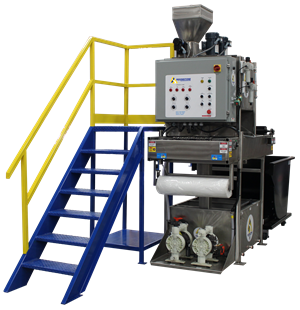The Solution to Costly Aircraft Paint Adhesion Failure
Lucas Dillingham, of surface inspection technology provider Brighton Science, offers insights for avoiding aircraft paint defects and adhesion failures.
Q: Do you have any advice for addressing paint adhesion problems for aircraft?
A: The importance of understanding surface quality and measuring it in an accurate, reliable, and demonstrable way is important for ensuring a high-quality finish and, ultimately, a high-quality product. Any manufacturer unable to do this increases their risk of producing inconsistent, poor-quality products and damaging both their reputation and their bottom line.
A major contributor to potential paint quality problems for aircraft manufacturers is the largely manual process for surface preparation. Because it is an expensive procedure to automate, it is done manually. As a result, it is difficult to measure surface quality, a critical capability that would help manufacturers avoid costly and time-consuming mistakes and potential damages — the cost to repaint a commercial jetliner is in the neighborhood of $100,000-$300,00 per aircraft.
There are several basic ways painted surfaces can fail, including:
- Pure adhesion failure in the field
- Paint that does not meet manufacturing specifications
- Paint that does not adhere properly due to surface contamination, resulting in a poor surface that suffers from crater-like rings (“fish eyes”) and peeling
- Failure of the topcoat to adhere properly to the primer
Topcoat peeling on an aircraft is perhaps the worst kind of failure. While the other coating failures are problematic and expensive to correct, topcoat peeling is a clearly apparent defect for all to see. The ease with which this highly visible problem can be quickly made public through mainstream and social media can be a public relations nightmare and a major corporate headache.
The 3 Material Systems to Understanding Failure Modes
Experienced commercial coating professionals know that to ensure a top-quality finish, there must be optimal interaction between the three materials involved: the substrate, primer, and topcoat. Any anomaly with any of these material systems that affects their ability to interact correctly will result in poor surface adhesion and correspondingly poor results.
Good adhesion starts with ensuring a scrupulously clean substrate that will enable the primer to adhere across the entire surface properly and consistently. It is important to note that primer can thicken with age — a primer that is too thick is weak, making it more difficult for the topcoat to adhere properly.
What makes the interface between primer and topcoat on aircraft exterior surfaces even more critical is the need for these systems to be resistant to chemical attack because these surfaces are exposed to hydraulic fluid, fuel, and maintenance chemicals when in service. Flexibility and adhesion of paint systems are crucial because of the thermo-cycling, aerodynamic forces, and body structure stresses put on the airplane between takeoff and landing. If the paint viscosity is too low during and after application, the paint will run and sag. Conversely, if the viscosity is too high, the paint does not flow well, resulting in a bumpy “orange peel” appearance.
The Secret to Success
Paint engineers can gain critical insight into the quality of the two interfaces between the three elements by measuring the contact angle of the surface — this reveals how well a compound will coat a surface. A contact angle (also referred to as a wetting angle) is formed when a drop of liquid is placed on a material surface and the drop forms a dome shape on the surface. The angle formed between the surface and the line tangent to the edge of the drop is called the contact angle. As the drop spreads across a surface and the dome becomes flatter, the contact angle becomes smaller. If the drop beads up on the surface (as you might see on a water-resistant article of clothing or a waxed car) the dome becomes taller, and the angle becomes larger.
When the angle the drop makes with the surface is measured, the resulting angle indicates whether the drop is more attracted to itself or to the surface it is on. Forces on the surface of the material start acting on the drop as soon as it hits the surface. If these forces are strong, their pull on the drop will cause it to “wet out” or spread further over the surface. If the forces are not stronger than the attractive forces the drop has for itself, then the drop will constrict into a shape as close to a sphere as it can. These two forces are working in tandem on the drop, creating an angle that can be measured. This measurement enables engineers to understand the relationship between the liquid drop and the surface. On a larger scale, this will reveal how well coatings such as primer and paint will adhere to a surface. Generally, greater wettability means greater adhesion for a better coating.
The ability to produce rapid, accurate and reliable surface contact angle data provides engineers with a tool that will enable them to determine a baseline for assessing coating adhesion quality — a key component of total quality control for many products. In the case of aircraft manufacturing, companies can use it to reduce paint failures and have a significant impact on their bottom line and customer satisfaction.
To learn more about how contact angle measurements provide a reliable method for manufacturers to easily monitor and maintain clean surfaces throughout development, production and repair, download the eBook “Checklist: Adhesion Failure Root-Cause Analysis for Manufacturers.”
About the Author

Lucas Dillingham
Lucas Dillingham is sales manager for Brighton Science. Visit brighton-science.com.
Related Content
Aerospace Conductive Coating Provides Adhesion, Fluid Resistance
Conductive coating (CM0485115) provides a high-conductivity solution for dissipating static on aluminum and composite aircraft.
Read MoreWastewater Contamination Removal System
Each environmentally beneficial system treats the wastewater stream at a fraction of the cost of larger, more complex industrial systems.
Read MoreA Smooth Transition from One Anodizing Process to Another
Knowing when to switch from chromic acid anodizing to thin film sulfuric acid anodizing is important. Learn about why the change should be considered and the challenges in doing so.
Read MoreTop Shop Emphasizes Dedication, Work Ethic
With a primary focus on aerospace and defense work, American Metaseal Corp. of Arbutus, Maryland, has qualified as a Top Shop on multiple occasions.
Read MoreRead Next
Integrating Industry 4.0 Solutions Into Your Coating Operation
Finishers and coaters are adopting automation solutions at an increasing rate. Jacob Fortmeyer offers insights for integrating new technologies into your process.
Read MoreThe Benefits of Benchmarking Surface Quality in Manufacturing
Lucas Dillingham, of surface inspection technology provider Brighton Science, offers insights for consistent, successful adhesion of coatings.
Read MoreHow to Keep Your Paint Booth In Peak Condition
Proper cleaning and maintenance are crucial for keeping your finishing equipment running optimally. Bill Day of Global Finishing Solutions discusses 5 ways to keep your paint booth clean and operating efficiently.
Read More





















